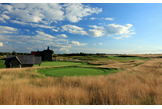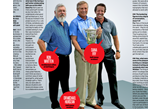US OPEN 2017: The men behind Erin Hills
Published: Last updated:
A pair of architects and a renowned golf course journalist joined forces to create the minimalistic master piece for this year’s US Open story – so we decided to meet Erin Hill’s unique design team.
Slightly more than a decade old, Erin Hills is a collaborative effort by Dr Michael Hurdzan, his former golf course design partner, Dana Fry, and Ron Whitten, the long-time architecture editor at Golf Digest.
Golf World talked with the trio about their minimalist Wisconsin creation, the sixth public-access course to host the US Open since 1999.
The USGA’s CEO Mike Davis once said Erin Hills was “Shinnecock Hills on steroids.” What’s your description?
Michael Hurdzan: I don’t think it’s similar to any course anybody knows. It has its unique properties. You could say it’s a little bit like Ballybunion, like Shinnecock, like Oakmont. I really think it’s its own personality. We call it a heartland golf course because it’s in the heartland of America.
Ron Whitten: We all agreed, once we saw this piece of property, that we could build a very natural course. We called it “Our Sand Hills” based on Sand Hills Golf Club in Nebraska, which I think is the most natural golf course in America. Bill Coore and Ben Crenshaw did a wonderful job of routing that course, moved very little earth. From the time we first saw the Erin Hills property, we thought that was achievable. There is no way that you could have humanly created some of the land forms out there. They’re unique to kettle moraine glacial property.
Michael and Dana, what was it like having a golf writer collaborating with you on Erin Hills?
Dana Fry: Ron’s seen as many good golf courses as any man alive. He understands what good golf architecture is. And he was as involved in the project as any of us. Lots of times, somebody puts their name on a project and they’re really on the outside looking in, but Ron was involved in everything from start to finish.
Michael Hurdzan: There’s no question Ron brought an enthusiasm and passion to the project. As excited as we were, his excitement transcended that, and he has a memory like a steel trap. He remembers so many great features, and I think we share a common value of what good golf is, what good strategic golf is. That’s why we were able to discuss situations and issues and always come to a collaborative answer
Ron, after critiquing so many courses in your career as an architecture writer, what was it like creating this course?
Ron Whitten: It was a dream come true. I was lucky enough to turn a hobby into a profession and become a golf writer. It’s been a dream of mine since I was 17 to design a golf course. This was a culmination of a couple of long-held dreams.
What were you thinking most about when you got started?
Ron Whitten: Nature. I went out and photographed water erosion, because I felt our course ought to have a unique bunkering style that people hadn’t seen before. I think we achieved that. We have some bunkers out there that really look like they were created by land slopes or water running downhill and kind of eroding in a finger-like fashion.
I took a lot of photos and did a lot of sketches that imitated that. We were also trying to keep things at grade. So 17 of the 18 greens we originally built were at grade. We were all on this mission of trying to respect the marvellous topography that we were allowed to work with.
The bunkering figures to be a big topic of conversation, doesn’t it?
Dana Fry: Many of the bunkers have elevation changes in the sand – they’re not necessarily a at bottom going up to a slope. They’re going to be hitting some shots from downhill, sidehill lies, trying to get up a five- foot bank. It’s not easy. You’ll see some unbelievably good shots, but you’ll also see some shots where they don’t get the ball out.

Ron, what were some of the pleasures of working as a designer instead of writing about somebody else’s work?
Ron Whitten: The thing of which I’ve always been envious of golf course architects is that they get to display creativity on a big scale. Even though we were working on land we were trying to let dictate what we did, you’re still being creative – the way you route the holes, where you place the tees, where you put the bunkers, even the green sites we located.
And I got to participate in all that with two of the best in the business. I learned stuff. I felt like I contributed stuff. I hated it when the course was complete and Bob said it was time to open it. That was the end of Christmas for me.
A lot of courses begin with one person’s dream. In the case of Erin Hills, that was Bob Lang, but after a number of twists and turns, he doesn’t own the course anymore. Are you all going to be thinking of him during the US Open?
Dana Fry: Bob had the dream. He knew it was a special piece of land, but he didn’t understand golf. As he got involved, he learned more and more about it. To say he was very driven and passionate would be an understatement. Without his foresight and vision and determination, none of us would be talking about Erin Hills today. Unfortunately, he couldn’t bring it to the finish line, and Andy Ziegler came in and spent a tremendous amount of money in doing the things that helped secure the US Open.
For a long time, the US Open was played only at private clubs. That’s changed a bit the last two decades. Are you pleased that Erin Hills is accessible?
Ron Whitten: I remember watching the Masters when I was 13 or 14 years old in the 1960s, and it took me until 2005 that I finally had the privilege to play Augusta National. I hope people will watch Erin Hills on TV during the US Open and realise they can play it. You can see the world’s best playing the course, and you can go play it yourself. I am very proud of that.
If you want to read more from our sister publication Golf World, subscribe to their magazine


